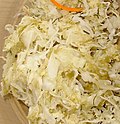Sauerkraut
Sauerkraut is a type of fermented cabbage that is popular in many Central European and Eastern European cuisines. The name "sauerkraut" is a German word that literally translates to "sour cabbage". It is made by a process of pickling called lactic acid fermentation, in which natural bacteria feed on the sugar in the cabbage leaves, producing lactic acid. This process not only preserves the cabbage but also gives sauerkraut its distinctive sour flavor.
History[edit]
The origins of sauerkraut are believed to date back to ancient times, with the Chinese using fermented cabbage as food during the building of the Great Wall of China. The technique was later brought to Europe, where it became a staple in German, Polish, and Russian diets. It was particularly valued for its vitamin C content, providing a crucial nutrient during the winter months when fresh vegetables were scarce.
Preparation[edit]
To prepare sauerkraut, finely shredded cabbage is mixed with salt and tightly packed into a sealed container. The salt draws out water from the cabbage, creating a brine that prevents the growth of unwanted microorganisms. Over a period of several weeks, the cabbage ferments at room temperature. During this time, the lactic acid bacteria naturally present on the cabbage leaves proliferate, fermenting the cabbage's sugars into lactic acid.
Nutritional Value[edit]
Sauerkraut is low in calories but high in vitamin C, dietary fiber, and probiotics, which are beneficial for the gastrointestinal tract. It is also a source of vitamin K, vitamin B6, folate, iron, potassium, and manganese.
Culinary Uses[edit]
Sauerkraut can be served both hot and cold and is often used as a side dish or condiment. It is a traditional accompaniment to dishes such as pork, sausages, and potatoes. In some cuisines, it is also used as a filling for dumplings and pierogi.
Cultural Significance[edit]
In addition to its culinary uses, sauerkraut holds cultural significance in many countries. It is associated with traditional celebrations and holidays, particularly in Germany and Eastern Europe. Sauerkraut is also celebrated for its health benefits, including its ability to aid digestion and boost the immune system.
See Also[edit]
-
Sauerkraut
-
Sauerkraut
-
Sauerkraut
-
Sauerkraut
-
Sauerkraut
-
Dumplings stuffed with sauerkraut
-
Cabbage Soup Kapuśniak
-
Czech sausages and sauerkraut
-
Vepřo knedlo zelo
-
Eisbein with sauerkraut
-
Choucroute
Ad. Transform your life with W8MD's Budget GLP-1 injections from $75


W8MD offers a medical weight loss program to lose weight in Philadelphia. Our physician-supervised medical weight loss provides:
- Weight loss injections in NYC (generic and brand names):
- Zepbound / Mounjaro, Wegovy / Ozempic, Saxenda
- Most insurances accepted or discounted self-pay rates. We will obtain insurance prior authorizations if needed.
- Generic GLP1 weight loss injections from $75 for the starting dose.
- Also offer prescription weight loss medications including Phentermine, Qsymia, Diethylpropion, Contrave etc.
NYC weight loss doctor appointmentsNYC weight loss doctor appointments
Start your NYC weight loss journey today at our NYC medical weight loss and Philadelphia medical weight loss clinics.
- Call 718-946-5500 to lose weight in NYC or for medical weight loss in Philadelphia 215-676-2334.
- Tags:NYC medical weight loss, Philadelphia lose weight Zepbound NYC, Budget GLP1 weight loss injections, Wegovy Philadelphia, Wegovy NYC, Philadelphia medical weight loss, Brookly weight loss and Wegovy NYC
|
WikiMD's Wellness Encyclopedia |
| Let Food Be Thy Medicine Medicine Thy Food - Hippocrates |
Medical Disclaimer: WikiMD is not a substitute for professional medical advice. The information on WikiMD is provided as an information resource only, may be incorrect, outdated or misleading, and is not to be used or relied on for any diagnostic or treatment purposes. Please consult your health care provider before making any healthcare decisions or for guidance about a specific medical condition. WikiMD expressly disclaims responsibility, and shall have no liability, for any damages, loss, injury, or liability whatsoever suffered as a result of your reliance on the information contained in this site. By visiting this site you agree to the foregoing terms and conditions, which may from time to time be changed or supplemented by WikiMD. If you do not agree to the foregoing terms and conditions, you should not enter or use this site. See full disclaimer.
Credits:Most images are courtesy of Wikimedia commons, and templates, categories Wikipedia, licensed under CC BY SA or similar.
Translate this page: - East Asian
中文,
日本,
한국어,
South Asian
हिन्दी,
தமிழ்,
తెలుగు,
Urdu,
ಕನ್ನಡ,
Southeast Asian
Indonesian,
Vietnamese,
Thai,
မြန်မာဘာသာ,
বাংলা
European
español,
Deutsch,
français,
Greek,
português do Brasil,
polski,
română,
русский,
Nederlands,
norsk,
svenska,
suomi,
Italian
Middle Eastern & African
عربى,
Turkish,
Persian,
Hebrew,
Afrikaans,
isiZulu,
Kiswahili,
Other
Bulgarian,
Hungarian,
Czech,
Swedish,
മലയാളം,
मराठी,
ਪੰਜਾਬੀ,
ગુજરાતી,
Portuguese,
Ukrainian












